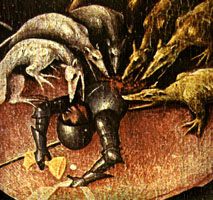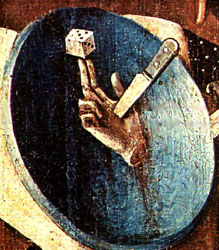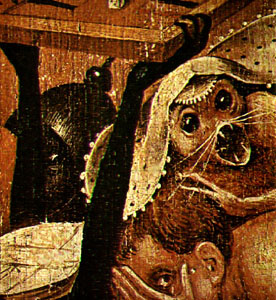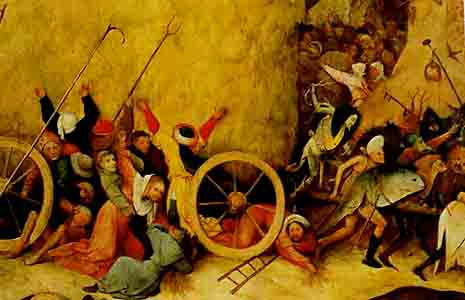





These are small excerpts from a triptych, "The Garden of Earthly Delight." It is a set of three folding wooden panels, with arching tops. The central panel is about 4 1/2 feet high and 2 1/2 feet wide. It also has a painting on the back: 'The Creation.' Fluted molding edges all three panels.
HIERONYMUS BOSCH - 1450[?] to 1516 born in 's-Hertogenbosch, Holland. Known popularly in Spain as 'El Bosco,' Bosch reflected in his work the anguished spiritual crisis of the 15 and 1600's. His paintings combine images of sublime mysticism and hellish torment, in a psychedelic, ergotic melange.
He used a lot of metaphors, partly because showing explicit images of the torture that was going on at the time would have gotten him into trouble. People strung onto musical instruments or broken under wheels are a common theme in his surviving work. (Much of his output has been lost.)
His style is to show a dense crowding of people, all enacting small stories, typical of day to day life. We see lovers, musicians, devils, popes, angels, kings, peasants, robbers, workmen, harlots, revellers, soldiers, and humanoid aliens, in myriad contortions- too much to get in a glance.

This is from 'The Hay Cart.' A 16th century torture method was to tie a person, spread eagled, on a wall. Red hot hooks were dragged through the flesh - and in this part of 'Carro de Heno,' people mimic that horror. People are also broken into wheels, and a demon whips his subhuman victims under a head hanging from a stick.
Bosch was the son of a painter, in a family of painters, from Aachen. The scanty records available indicate that he had a rich wife, 25 years his senior. Free from the need of money, he was able to paint what he wanted. A core member of the 'Brotherhood of Our Lady,' Bosch was commissioned to do many works, both clerical and secular. His Diablerie style became popular in the early part of the 16th century. It is unclear if his public understood his work - reviews of the time show a complete lack of perception. Its value as a curiosity overshadowed the deeper implications, leaving those to private interpretation.
It seems that Bosch disapproved of the bawdy, lawless activities of the lower classes, and was offering cautionary tales about the consequences of sin. The Dark Ages were ending, and the poor and lazy were being increasingly ostracized.
Here is a close up of the lower left panel. (86 kb)